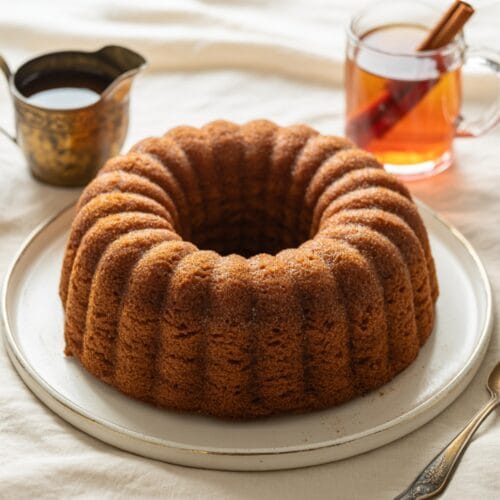
Apple Cider Doughnut Cake
A moist, tender bundt cake infused with concentrated apple cider and warm spices, finished with a buttery cinnamon-sugar coating that perfectly mimics the beloved fall treat of apple cider doughnuts—without the fuss of deep frying.
Ingredients
- 2 cups apple cider reduced to 1/2 cup
- 3 cups all-purpose flour
- 1 1/2 teaspoons baking powder
- 1/2 teaspoon baking soda
- 1 teaspoon salt
- 1 1/2 teaspoons ground cinnamon
- 1/4 teaspoon ground nutmeg
- 1/2 cup 1 stick unsalted butter, at room temperature
- 1/2 cup vegetable oil
- 1 cup granulated sugar
- 1/2 cup light brown sugar packed
- 3 large eggs at room temperature
- 1 teaspoon vanilla extract
- 1/2 cup buttermilk at room temperature
For the cinnamon-sugar coating
- 6 tablespoons unsalted butter melted
- 3/4 cup granulated sugar
- 1 1/2 teaspoons ground cinnamon
Instructions
- Reduce the apple cider by pouring the 2 cups of cider into a small saucepan and bringing it to a simmer over medium-high heat. Continue simmering for about 15-20 minutes until it reduces to 1/2 cup of concentrated cider. Set aside to cool completely.
- Preheat your oven to 350°F (175°C) and generously grease and flour a 10-inch bundt pan, making sure to coat all the nooks and crannies.
- Whisk together the dry ingredients in a medium bowl: flour, baking powder, baking soda, salt, cinnamon, and nutmeg. Set aside.
- Cream the butter, oil, and sugars in a large bowl using an electric mixer on medium speed until light and fluffy, about 3-4 minutes. Don’t rush this step—proper creaming creates that perfect tender crumb.
- Add the eggs one at a time, beating well after each addition. Scrape down the sides of the bowl as needed to ensure everything is evenly incorporated.
- Beat in the vanilla extract and cooled cider reduction until completely combined. The mixture might look slightly curdled, but don’t worry—that’s normal.
- Gradually add the flour mixture in three additions, alternating with the buttermilk (begin and end with flour), mixing on low speed just until combined after each addition. Be careful not to overmix.
- Pour the batter into the prepared bundt pan and smooth the top with a spatula. Tap the pan gently on the counter a few times to release any air bubbles.
- Bake for 45-50 minutes or until a toothpick inserted in the center comes out clean. The top should be golden brown and spring back when lightly touched.
- Allow the cake to cool in the pan for exactly 10 minutes—any longer and the coating won’t adhere properly; any shorter and the cake might break.
- Prepare the coating while the cake is cooling by mixing the sugar and cinnamon in a shallow dish.
- Carefully invert the cake onto a wire rack set over a baking sheet (to catch any sugar drips). Brush the warm cake all over with melted butter, then immediately sprinkle and press the cinnamon-sugar mixture over the entire surface.
- Let the cake cool completely before slicing and serving, allowing the coating to set and form that characteristic cider doughnut crust.
Notes
- The key to this recipe’s intense apple flavor is reducing the cider—don’t skip this step! You can reduce it up to 3 days ahead and keep refrigerated.
- Room temperature ingredients are crucial for achieving the perfect texture, so plan ahead.
- For an extra-special touch, add 1/2 cup of finely chopped dried apple pieces to the batter.
- The cake actually tastes even better the next day, as the flavors have time to meld together.
- Store at room temperature in an airtight container for up to 3 days, or freeze uncoated cake for up to 3 months.